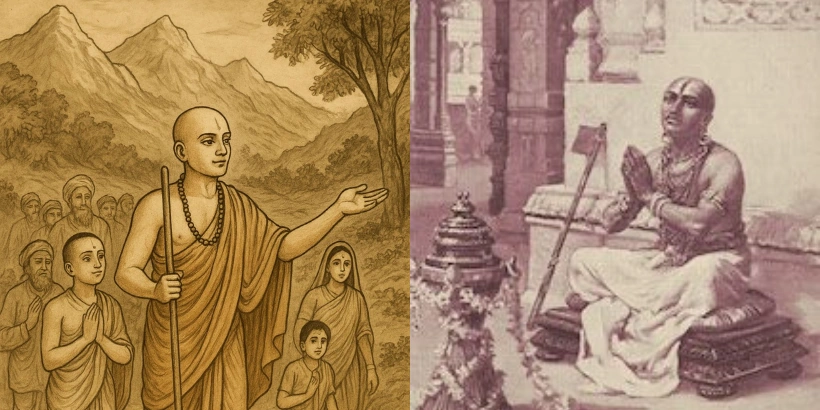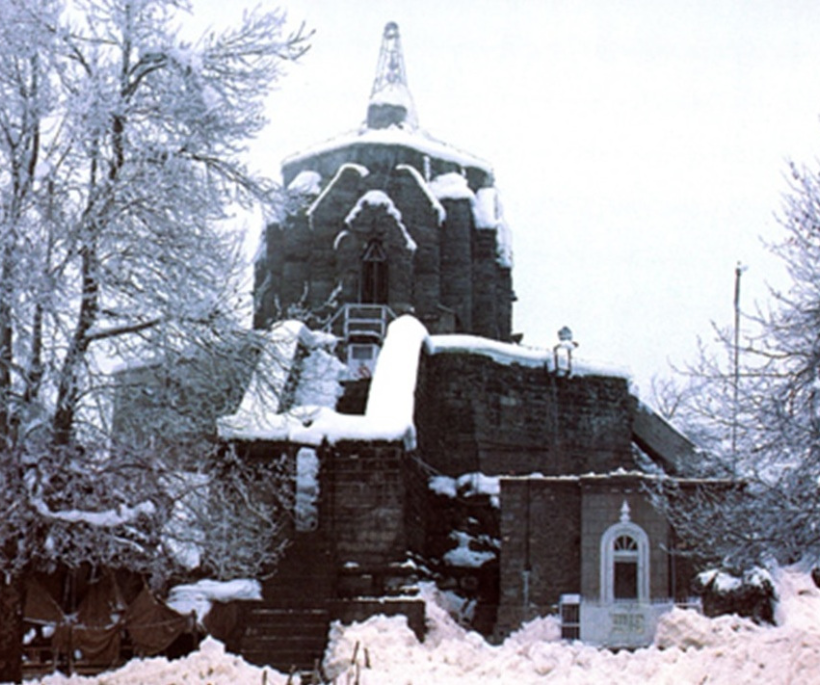-

Kashmir & Vaishnavism Series: Part 1
Rāmanujāchārya’s Kashmir Yatra: Historical, Theological and Institutional Significance03/09/2025 By RitvikIntroduction
Sri Rāmanujāchārya (1017–1137 CE) is the most prominent exponent of Vishishtādvaita Vedānta, a sub-school of Vedānta subscribed to by the Sri Vaishnava Sampradāya (a traditional and ancient Vedic Vaishnava sect). According to this school, the highest supreme truth and Being (the parabrahman) without a second is Sriman Nārāyana - the causeless cause within whom the divine leela of creation, preservation and dissolution of the universe occurs whilst He pervades the entire existence by being the innermost indwelling supreme soul (antaryāmi) of both the sentient and insentient entities that constitute His attribute/mode (angās). The ultimate purpose of all individual souls is to get liberated from samsara through devotional surrender to Sriman Nārāyana alone, thus attaining eternal bliss by rendering loving devotional service (nitya kainkaryam) to Him in the eternal abode of Vaikuntha.
Rāmānuja undertook a legendary journey from the Sri Vaishnava heartland and temple town of Srirangam in Tamil Nadu to the Sharada Peetham far northern region of Kashmir. This journey was not a mere pilgrimage but a scholarly mission with profound historical and theological ramifications. According to traditional accounts, Rāmānuja traveled to the famed Shārada Peetham in Kashmir with the specific purpose of consulting the Bodhāyana Vritti, an ancient commentary on the Brahma Sūtras, the third canonical pramana text of Vedānta (after the Upanishads and Bhagavad Gita) based upon which the different Vedānta siddhāntha (schools of thought) were formally constructed and propagated.
This article examines the significance of Rāmānuja’s Kashmir yātrā, the importance of Shārada Peetham as a seat of learning, and the divine dimension of the journey – notably Ramanuja’s association with Lord Hayagrīva. We further explore how the Hayagriva tradition, inaugurated by Ramanuja, was deepened by the second most prominent stalwart acharya in the Visishtādvaita Vedānta based Sri Vaishnava sampradaya, Sri Vedānta Desika (1268–1369 CE), and institutionalized in the Brahmatantra Svatantra Parakāla Matha which is a living monastery in Mysuru, Karnataka. Through historical narrative and theological analysis, we illuminate the symbolic meaning of this episode and its reverberations in the Srivaishnava tradition.
A Journey in Search of Lost Knowledge: Ramanuja and the Bodhāyana Vritti
In an era long before modern libraries or digital archives, accessing a rare manuscript could entail arduous travel. By the 11th–12th century, the Bodhayana Vritti, an extensive gloss on the Brahma Sūtras, was known to exist only in Kashmir. Bodhāyana was an early Vedantic sage whose commentary (vritti) on Vyasa’s Brahma Sūtras and Jaimini’s Purva Mimāṁsā Sūtras was held in great esteem. Ramanuja, preparing to write his own Brahma Sūtra commentary, his magnus opus called the Śrī Bhāshya, felt it imperative to ground his work in the insights of this predecessor. Thus, he embarked on a trek of thousands of kilometers from Srirangam (Tamil Nadu) to the Himalayas – a testament to the pan-Indian unity of scholastic pursuit in medieval India.
Historical evidence and hagiographies suggest that Ramanuja made his journey to Kashmir sometime before 1099 CE (prior to age 60, after which he was exiled from Tamil Nadu). Traveling with a few close disciples, most notably with his closest and most sincere pupil Kureśa (Koorathālvān) – he braved the difficult terrain and political uncertainties to reach the sacred knowledge center of Sharada Peetham, which was already renowned as an ancient Sarvajñapīṭha (“seat of omniscience”) thanks to its legacy associated with Adi Shankaracharya (who predated Ramanujacharya by several centuries) and temple-university dedicated to the goddess Sharada (Sarasvatī). Between the 6th and 12th centuries, Sharada Peetham stood among the subcontinent’s preeminent institutions of higher learning, famed for its rich library. Indeed, historical records recount that scholars of many traditions traveled great distances to access its manuscripts. Even the Jain polymath Hemachandra, for example, obtained grammatical texts from Sharada Peetham to compile his Siddha-Hema grammar in the 12th century. It was in this milieu of vibrant intellectual exchange that Ramanuja sought the Bodhāyana Vritti whose only storehouse was Kashmir.
Upon reaching Sharada Peetham, Ramanuja’s scholarly quest met with both success and challenge. The Kashmiri pandits, proud guardians of their rare manuscripts, allowed the Acharya to consult the solitary copy of Bodhāyana’s Vritti but under strict conditions - he was allowed to read the manuscript on site but was forbidden from copying it or carrying it away. Tradition vividly describes how Kureśa, blessed with a prodigious memory, accompanied Ramanuja into the library. By lamplight, he memorised the entire Vritti verbatim as Ramanuja read it aloud!
Back in Srirangam, Ramanuja and Kureśa transcribed and studied Bodhāyana’s commentary in depth. This material became the substratum for Śrī Bhāshya, Ramanuja’s magnum opus on the Brahma Sūtras. In the very opening of Śrī Bhāshya, Ramanuja pays homage to the ancient masters (the pūrvāchāryas), declaring his intention to follow “the path shown by the vrittikāra” (the author of the Vritti) and other revered teachers. Such deference highlights the institutional significance of the Kashmir episode.
Ramanuja’s Vision of Saraswati and Gift of Hayagrīva
Having thoroughly studied the Bodhāyana Vritti, Ramanuja completed his Śrī Bhāshya – a seminal commentary that established the Vishishtadvaita philosophy. According to tradition, this accomplishment was met with an extraordinary event: Goddess Saraswati appeared to acknowledge and bless Ramanuja’s work. As the story goes, upon the completion of Śrī Bhāshya in Kashmir (or alternatively, upon Ramanuja’s return to Srirangam, depending on the source), the goddess manifested before the Acharya. Overjoyed by the “grand work” he had composed, she conferred on him the honorific title “Bhashyakāra” (“the commentator” par excellence). This title signified that Ramanuja had now assumed his place among the great interpreters of Vedānta, a mantle Saraswati deemed worthy of. In the Sri Vaishnava liturgical tradition to this day, Ramanuja is often hailed as “Sri Bhāshyakārar,” reflecting this divine title bestowed in Kashmir by the Sharada Devi.
Most significantly, the goddess presented Ramanuja with a murti (sacred icon) of Lord Hayagrīva as a personal gift. Hayagriva is an incarnation of Lord Vishnu depicted with the head of a horse and a human body, celebrated as the embodiment of wisdom and the patron of learning. Hayagriva is revered for restoring the Vedas: when the demon Madhu–Kaiṭabha stole the Vedas and hid them in the cosmic ocean, Vishnu took the Hayagriva form to slay the demons and rescue the sacred knowledge for Brahmā. The choice of this deity as Saraswati’s gift to Ramanuja is theologically profound. It suggests a harmonious convergence of Shakta and Vaishnava icons: the goddess of learning hands over her own worshipful icon of knowledge (Hayagriva) to the Vaishnava saint, as if recognising that Vishnu as Hayagriva is the ultimate source of the wisdom she dispenses to continue seeking enlightenment from Lord Hayagriva, the supreme “ādhāraṃ sarva-vidyānām” (support of all knowledge).
The Hayagriva idol would become Ramanuja’s araadhya murti (primary worship deity) in his personal devotions. Hayagriva-Arādhanā, i.e the daily ceremonial worship of Lord Hayagriva, was thereby established in the Sri Vaishnava tradition by Ramanuja’s example. This represented a theological statement: just as Vishnu in the Hayagriva form had restored the lost Vedas, so too had Vishnu’s grace enabled Ramanuja to recover Bodhāyana’s lost teachings and illuminate them in Śrī Bhāshya. The parallels between myth and history are striking and likely intentional. Ramanuja’s journey to Kashmir and recovery of the Vritti was metaphorically akin to retrieving sacred knowledge from obscurity (just as Hayagriva retrieved the Vedas from the netherworld). Small wonder, then, that Ramanuja chose to honor Hayagriva for the rest of his life as he carried the Hayagriva murti with him and worshipped it wherever he went.
Vedanta Desika and the Installation of Hayagriva
Two centuries after Ramanuja, the Hayagriva tradition found its most eloquent exponent in Sri Vedanta Desika (born as Venkatanātha, 1268–1369 CE in an agraharam called Thooppul in Kanchipura, as the avatara of the holy ghanta bell of Sri Venkateshvara of Tirumala). Vedanta Desika is revered as the most qualified, unrivalled acharya of Sri Vaishnavism and was a polymath, poet-philosopher, and the foremost ācārya after Ramanuja to further formalise and defend Vishishtadvaita Vedānta against all other schools of thought.
Vedanta Desika’s connection to the Ramanuja-Hayagriva lineage can be traced through both lineage and inspiration. According to biographical chronicles, the very Hayagriva idol that Ramanuja received from Saraswati eventually came into Desika’s possession. The lineage of transmission is described thus: Ramanuja passed the idol to his disciple (and relative) Kūrathālvān (Kureśa), from whom it went to Kureśa’s son (Parāśara Bhattar) or one of the simhāsanādhipati appointed successors. Over generations, it was kept by senior acharyas; by the 13th century it was held by the family of Kidāmbi Appullar (Ātreya Rāmānuja), who was Vedanta Desika’s maternal uncle and guru. Desika grew up under the tutelage of Appullar, and upon his guru’s passing, Desika embarked on a period of intense meditation and austerity at Tiruvahīndrapuram in Tamil Nadu.
It was at Tiruvahindrapuram’s Oushadhagiri hill that Vedanta Desika had a mystical encounter reinforcing the Hayagriva devotion. Tradition recounts that Desika performed penance reciting the Garuḍa-mantra (taught by Appullar) on this hil. Pleased by his devotion, Garuḍa (the eagle mount of Vishnu) appeared and initiated him into the Hayagriva-mantra – the sacred formula of Hayagriva. At that very moment, Vedanta Desika was blessed with a divine vision of Lord Hayagriva. Overwhelmed, the young acharya began to compose extemporaneously in Sanskrit, and thus was born the Hayagriva Stotram, Vedanta Desika’s first and one of his most famous hymns. The opening verse of this stotram (drawn from the Pāñcarātra Āgama) has become a standard prayer for students in the Sri Vaishnava community: “jñānānandamayaṁ devaṁ nirmala-sphaṭikākṛtiṁ | ādhāraṁ sarva-vidyānāṁ hayagrīvaṁ upāsmahe” – “We meditate upon Lord Hayagriva, who is the personification of knowledge and bliss, whose form is pure and crystal-like, and who is the foundation of all learning.”
Desika explicitly sought Hayagriva’s blessings for mastery of words and thought, a boon he felt was crucial to carry forward the Vedantic teaching in an age of intellectual rivalries. Notably, Desika became an undisputed master of an astonishing array of disciplines – from poetry, logic, and philosophy to astronomy, architecture, and even cuisine and sculpture. Hagiographers attribute this genius to Hayagriva’s grace: Desika himself humbly wrote that people believe he is an incarnation of the Lord’s bell (which destroyed false doctrines), but it was truly by Hayagriva’s blessings that he attained prodigious knowledge. The tradition thus treats Vedanta Desika as a living testimony to the efficacy of Hayagriva upāsanā (worship) – “if Lord Hayagriva blesses any soul, Goddess Saraswati will reside on that person’s tongue” as a popular verse goes.
Crucially, the very Hayagriva idol given by Saraswati to Ramanuja found its home with Vedanta Desika through the hands of one Sudarśana Bhaṭṭar (Pundarīka-kaksha), who was the son-in-law of Desika’s guru Appullar. From then on, Desika worshipped Lord Hayagriva daily as his personal Deity (nitya-arādhana mūrti) and in every place Desika lived, whether Kanchi, Srirangam, Satyakalam, or Melkote – he carried this icon and continued the Hayagriva-pūjā. It is said that before composing any major work.
The Brahmatantra Svatantra Parakāla Matha: Institution of an Unbroken Tradition
The Hayagriva worship inaugurated by Ramanuja and invigorated by Vedanta Desika did not remain a private practice but became institutionalised. The vehicle for this was the Sri Parakāla Matha, a Vaishnava monastery that emerged in the 14th century as a direct continuation of Desika’s lineage. The Parakāla Matha (formally, Sri Brahmatantra Svatantra Parakāla Swami Mutt) holds a unique place in Srivaishnavism as the first major Vadakalai monastery, dedicated to upholding Vedanta Desika’s teachings. Historically, the matha was founded by one of Desika’s foremost disciples, Sri Brahmatantra Svatantra Jīyar, around 1338 CE. Under Desika’s guidance, this disciple established a monastic order initially in Thūppul (Desika’s birthplace in Kanchipuram). Later, in the 17th–18th centuries, the matha’s headquarters moved to Mysore in Karnataka, where it gained the patronage of the Maharajas of Mysore. The term Parakāla (“Beyond Time” or an epithet of Lord Narasimha) was an honorific derived from one of the early pontiffs ( a title earned by one of the 12 most prominent Vaishnava mystics Tirumangai Āzhvār, and adopted by the matha) but it also symbolically indicates the matha’s claim to timeless wisdom.
At the heart of Parakāla Matha’s spiritual life is the daily worship of Sri Lakshmi Hayagriva. The presiding deity of the matha is none other than the same Lakshmi-Hayagriva idol that Ramanuja received and Desika cherished. In fact, the matha’s records proudly note: “The Mutt houses the precious Sri Lakshmi Hayagriva Moorthy which was originally worshipped by Bhagavad Ramanuja, later by Swami Deshikan and subsequently passed on through a line of pontiffs in unbroken succession.” Even today, if one visits the Parakāla Matha in Mysuru, one can have darshan of this deity: a small but exquisitely decorated icon of Hayagriva with Sri (Lakshmi) seated on his lap, emanating an aura of scholarly serenity. The daily arādhanā (ritual service) to Sri Hayagriva at the matha is performed with strict adherence to tradition, including Vedic chants and Vedanta Desika’s Hayagriva Stotra. Special worship is conducted on Hayagriva Jayanthi (the full moon of Śravaṇa month, considered Hayagriva’s appearance day) and during Navaratri’s Mahanavami, occasions when students and scholars flock to seek blessings for academic success
Conclusion
Ramanuja’s Kashmir expedition emphasizes the inter-regional connectedness of India’s knowledge traditions. It is a striking early example of what we might call knowledge repatriation or retrieval. Just as centuries later, scholars like Dayananda Saraswati or Orientalists would scour libraries to recover lost texts, Ramanuja did so in the 11th century by physically traveling to a far-off repository. This underscores that the subcontinent, despite political fragmentations, had a cohesive intellectual life – a Tamil Nadu Acharya could think nothing of depending on Kashmiri pandits for a crucial resource. The incident also shines light on the state of textual preservation: by Ramanuja’s time, southern India apparently lacked certain early Vedānta texts (perhaps due to wars or limited manuscript copying), whereas Kashmir, which had been a stronghold of both Buddhist and Hindu scholarship, still held such works. Sadly, within a few centuries, Kashmir itself would face turmoil (Islamic conquests by the late 14th century led to the decline of Sharada Peetham). Ramanuja’s timing was fortunate; he accessed Sharada Peetham at its tail end of glory (the last flicker of the flame, as it were).
One might imagine that by consulting and carrying Bodhāyana’s wisdom back to the South, Ramanuja helped preserve it for posterity even as the original Kashmiri manuscript might have been lost in subsequent generations. Indeed, Śrī Bhāshya quotes or paraphrases Bodhāyana in numerous places, thus indirectly preserving fragments of that ancient commentary within its own text. The journey also had the effect of elevating Ramanuja’s stature among contemporaries: just as Shankara’s pan-Indian travels gave him ecumenical authority, Ramanuja’s Kashmir yatra and his triumph in procuring the Vritti would have marked him as a pan-Indian scholar, not merely a parochial leader. It bridged North and South in the spiritual geography of India, a legacy that his followers proudly remember.
Bibliography
- Desikan, Vedanta. Hayagriva Stotram. (Translation and commentary in English) – see significance of opening verses on Hayagriva’s form and role
- Krishnaswami, K. R. Hayagreeva Avatara and the History of Parakala Mutt. A & K Publications, 2007 – introduction recounting the journey of the Hayagriva idol from Saraswati to Ramanuja to Parakala Mutt
- Sri Ramanujacharya’s Life and Teachings – Jeeyar Educational Trust (JET) – biographical highlights of Ramanuja, including the Kashmir episode and Saraswati’s apparition
- Dharmawiki – Ramanujacharya – historical analysis of Ramanuja’s travels, sources on the Bodhayana Vritti retrieval and its timeline
- Anarghyaa (Blog). “Kashmir Saraswati Temple – Sharada Peeth” (2020) – on Sharada Peeth’s significance and Ramanuja’s visit
- Raja Thatha’s Blog. “Saint Ramanuja’s visit to Kashmir” (P.R. Ramachander, 2020) – narrative of Kuresa memorizing the Bodhayana Vritti in Kashmir
- Wikipedia. “Sharada Peeth” – historical overview of Sharada Peeth as a center of learning and its role in Indian scholarship
- Parakala Matha Official Website – information on the Lakshmi-Hayagriva deity and the acharya lineage of the Matha
- “Vedanta Desika: A polymath with brilliance” – biographical details on Desika receiving the Hayagriva idol and composing the Hayagriva stotra


